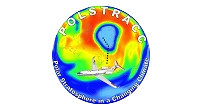Scientific objectives: Difference between revisions
From Polstracc
Content deleted Content added
mNo edit summary |
|||
| Line 1: | Line 1: | ||
== Key issues adressed by POLSTRACC are: == |
== Key issues adressed by POLSTRACC are: == |
||
* Improving the understanding of chemical and physical processes involved in polar ozone loss |
|||
* The structure of Arctic LMS: How large are the contributions of (ii) polar vortex air, (ii) extra-vortex stratospheric air and (iii) tropospheric air? |
|||
* Detailed investigation of structure and composition of the climate-sensitive UTLS region at high latitudes with focus on LMS region, the direct interface between stratosphere and tropopause |
|||
* The outflow of the polar vortex: How much vortex air descends through the bottom of the polar vortex during the course of the winter? To which extend are the chemical composition and the radiative balance of the surrounding LMS and the adjacent tropopause region affected? How efficient are stratosphere-troposphere exchange processes in the Arctic? |
|||
* Investigation of outflow of the Arctic polar vortex into the LMS region and subsequent transport to lower latitudes and mixing with extra-vortex air |
|||
* Arctic cirrus clouds: To which extend do cirrus clouds around the Arctic tropopause and LMS region disturb chemical budgets (especially ozone) through heterogeneous reactions? Which role do cirrus clouds play in chlorine activation? How are the the budgets of water vapour and reactive nitrogen are affected by dehydration and denitrification through cirrus cloud particles? |
|||
* Improving the knowledge on the properties of polar stratospheric clouds (PSCs) and vertical redistribution of nitrogen-containing compounds by PSC particles into the lower stratosphere |
|||
* Polar stratospheric clouds (PSCs): How deep do polar stratospheric clouds penetrate into the lower stratosphere region? How strong is the LMS region disturbed by renitrification of nitric acid trihydrate (NAT) particles? How strong is the linkage between the occurence of PSCs and tropospheric clouds? |
|||
* Investigation of the role of Arctic cirrus clouds affecting the chemical composition Arctic ULTS |
|||
* Gravity waves: How do gravity waves affect the stability of the Arctic polar vortex? |
|||
* Monitoring of the spatial and temporal variability of trace constituents and aerosols in the Arctic UTLS region during different phases of the polar winter |
|||
* Role of the Arctic LMS and tropopause region in climate: How sensitive is the climate to changes in the chemical composition of this region? What are the dominant processes affecting ozone in this vertical range? How will the extent of Arctic cirrus cloud and PSC formation evolve in future and what are the consequences? |
|||
* |
* Improving model simulations for evolution of the ozone layer and the knowledge on the role of the ULTS region in the climate system |
||
*Providing global models with accurate data from the deployments and to refine their algorithms |
|||
climate |
|||
*Investigations whether the models can reproduce the spatial an temporal changes in ozone and relevant trace gases |
|||
<br/><br/> |
<br/><br/> |
||
Revision as of 16:41, 9 October 2013
Key issues adressed by POLSTRACC are:
- Improving the understanding of chemical and physical processes involved in polar ozone loss
- Detailed investigation of structure and composition of the climate-sensitive UTLS region at high latitudes with focus on LMS region, the direct interface between stratosphere and tropopause
- Investigation of outflow of the Arctic polar vortex into the LMS region and subsequent transport to lower latitudes and mixing with extra-vortex air
- Improving the knowledge on the properties of polar stratospheric clouds (PSCs) and vertical redistribution of nitrogen-containing compounds by PSC particles into the lower stratosphere
- Investigation of the role of Arctic cirrus clouds affecting the chemical composition Arctic ULTS
- Monitoring of the spatial and temporal variability of trace constituents and aerosols in the Arctic UTLS region during different phases of the polar winter
- Improving model simulations for evolution of the ozone layer and the knowledge on the role of the ULTS region in the climate system
climate
